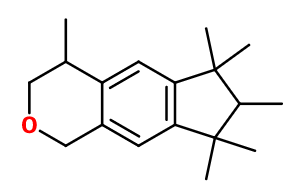
Photo credits: ScenTree SAS
| Company | Ingredient Name | ID | Comments | Naturality | Certifications | Purity | Latin name | Treated part | Geographical origin | MOQ |
|---|---|---|---|---|---|---|---|---|---|---|
|
|
Galaxolide DPG - 30 Gr | - |
Visit website
|
- | - | - | - | - | - |
General Presentation
-
CAS N° : 1222-05-5
-
EINECS number : 214-946-9
-
FEMA number : Donnée indisponible.
-
FLAVIS number : Donnée indisponible.
-
JECFA number : Donnée indisponible.
-
Appearance : Colorless viscous liquid
-
Density : 1,037
-
Volatility : Base
-
Price Range : €
Physico-chemical properties
-
Molecular formula : C18H26O
-
Molecular Weight : 258,41 g/mol
-
Log P : 5,92
-
Fusion Point : Donnée indisponible.
-
Boiling Point : 304°C
-
Detection Threshold : 0,9 ng/l air
-
Optical rotation : Donnée indisponible
-
Vapor pressure : Donnée indisponible
-
Refractive Index @20°C : Donnée indisponible
-
Acid Value : Donnée indisponible.
-
Flash Point : >100°C (>212°F)
Uses
Uses in perfumery :
Galaxolide® gives hold and trail to a perfume. It is one of the freshest and most heady musks. To be combined with other musks to multiply the facets. Widely used in detergents and fabric softeners. Preferential use in laundry. Often used as a replacement for all other musks in the case of a reformulation at a lower cost.
Year of discovery :
Discovered in 1962.
Natural availability :
Galaxolide® is not available in its natural state.
Isomerism :
Galaxolide® contains several asymmetric carbons that give rise to several enantiomers. Thus, Galaxolide® used in perfumery is actually a mixture of at least seven isomeric molecules with different volatilities. Galaxolide® and Tonalide® are constitutional isomers and have a fairly similar overall structure. Both have a relatively similar smell, as they belong to the same family of musks.
Synthesis precursor :
Galaxolide® is not a precursor to the synthesis of another compound of olfactory interest.
Synthesis route :
Galaxolide® can be synthesized from tert-amylene by reaction with alpha-methylstyrene, to obtain 1,1,2,3,3-pentamethylindane. This intermediate molecule can be hydroxyalkylated by reaction with the propylene oxide, during a Friedel and Craft reaction, catalysed by aluminum chloride, for example. The alcohol function of the second intermediate product obtained during the previous process can be cyclized by reaction with formaldehyde, either in an alcoholic medium or with an acid anhydride, to obtain the final compound, Galaxolide®.
Regulations & IFRA
Allergens :
This ingredient does not contain any allergen.
IFRA 51th :
This ingredient is not restricted for the 51th amendment


